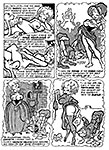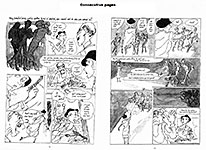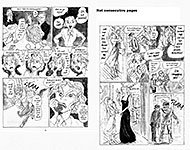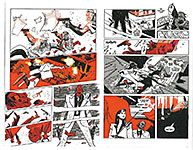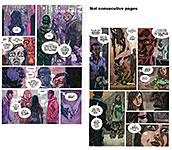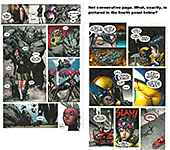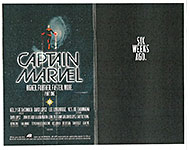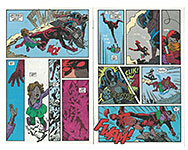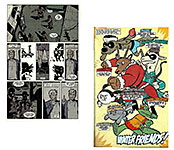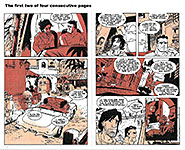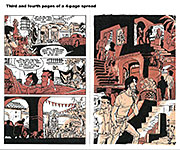 |
||
Opus 323 (April 17, 2014). Down the rabbit hole this time, we review and applaud Jules Feiffer’s first graphic novel, Kill My Mother, and several first issues of funnybooks, and report on Archie’s impending death, a new animated Peanuts, the plethora of superflicks, NCS division award nominees, the current crop of editoons, weed in Colorado—and more, much more. Here’s what’s here, in order, by department—:
NOUS R US NCS Division Award Nominees Anniversaries: Dr. Seuss, Australian Cartoonists Jack Ohman: Best in the West Editoonist Signe Sued Archie on Death Row Peanuts Legacy: New Animated Film Spider-Man et al: Too Many Superflicks? History Repeating Itself Again Stan Lee in Playboy
Report on Weed in Colorado
EDITOONERY Current Crop of Political Cartoons on the Issues
NEWSPAPER COMICS PAGE VIGIL Venerable Taboos Being Violated
BOOK MARQUEE New Biography of Robert Ripley, Believe It Or Not
LONG FORM COMICS (Graphic Novel) Jules Feiffer’s First, Kill My Mother
FUNNYBOOK FAN FARE First Issues Reviewed: Moon Knight, White Suits, Veil, Starlight Ms. Marvel Improved Wolverine, Captain Marvel—All the Same Stuff Daredevil and Hawkeye, Still Superior Savage Dragon Starts Over Sergio Aragones’ Funnies The Saviors Brother Lono Ends
Obit: Fred Kida
Our Motto: It takes all kinds. Live and let live. Wear glasses if you need ’em. But it’s hard to live by this axiom in the Age of Tea Baggers, so we’ve added another motto:.
Seven days without comics makes one weak. (You can’t have too many mottos.)
And our customary reminder: don’t forget to activate the “Bathroom Button” by clicking on the “print friendly version” so you can print off a copy of just this installment for reading later, at your leisure while enthroned. Without further adieu, then, here we go—:
NOUS R US Some of All the News That Gives Us Fits THE NOMINEES for the National Cartoonist Society’s “Division Awards” have been posted at the NCS website. NCS “divisions” encompass cartooning endeavors in all the venues from newspaper comic strips to television animation and advertising and more. Here are the nominees in the divisions we attend to at this site: Editorial Cartooning —Clay Bennett, Adam Zyglis, Mike Ramirez (two liberals and one conservative, Ramirez); Newspaper Panel Cartoons—Dave Coverly, Speed Bump; Scott Hilburn, Argyle Sweater; Mark Parisi, Off the Mark; Magazine Cartooning—Matt Diffee, Bob Eckstein, and Mike Twohy (all New Yorker cartoonists; Twohy is also up for “short form online cartooning”); Comic Books—Sergio Aragones, Sergio’s Funnies; Jay Fosgitt, Bodie Troll; and Chris Samnee, Daredevil; Graphic Novel—Dan E. Burr, On the Ropes; Rick Geary, Madison Square Tragedy (see Opus 319); Andrew C. Robinson, The 5th Beatle; Comic Strip—Isabella Bannerman, Six Chix (six women cartoonists rotate through the days of the week, each doing one strip a week); Terri Liebenson, Pajama Diaries; Mark Tatulli, Lio. Not a bad selection, over-all—although professional nit-pickers like me might sniff at the magazine cartooning nominees being all New Yorker cartoonists; admittedly, the only other well-known national venue for gag cartooning is Playboy —but none of its cartoonists seem to show up in these listings, year after year. NCS has finally started recognizing online cartooning, dividing the field into two categories: “long form” (akin to comic books/graphic novels) and “short form” (laugh-a-day stuff, single panel gag cartoons and comic strips). Nominees in the other divisions are listed at reuben.org. Winners will receive their plaques at the Reubens Banquet on Saturday, May 24, during the NCS annual meeting (this year, in San Diego).
Anniversaries
and Etc. Jack Ohman, editorial cartoonist at the Sacramento Bee, was named Best of the West, a journalism contest for papers, magazines and news websites operating in Alaska, Arizona, California, Colorado, Hawaii, Idaho, Montana, Nevada, New Mexico, Oregon, Texas, Utah, Washington and Wyoming. Ohman was cited for cartoons on NSA spying and government shutdown. Second place went to Mike Smith of the Las Vegas Sun; third, to John Pritchett of Honolulu Civil Beat.
EDITOONIST SUED Alan Gardner
at DailyCartoonist.com reports that Philadelphia Daily News and Inquirer editorial cartoonist Signe Wilkinson was among several people connected
to the newspapers named in a defamation suit filed by Pennsylvania Supreme
Court Justice Seamus McCaffery and his wife and judicial aide Lise Rapaport,
who allege the paper conducted a smear campaign. The suit mentions the
accompanying Signe cartoon satirizing Rapaport’s receiving fees for referring
cases to personal injury firms. Gardner didn’t go into the case’s convoluted legal machinations but said: “On the face of it, I can’t think of a case (nor can I find one online) where a cartoonist has been successfully found guilty of defamation in the US. Most cases I’ve heard about are quickly tossed out. In this case, it’s the reporting of the paper that is in question and not specifically Signe, so I’m not sure how that changes the dynamics of the case as far as Signe is concerned.” The circumstance prompted some on the e-mail list of the Association of American Editorial Cartoonists to recall times that they’d been sued, always unsuccessfully. Few of the cases made it to court and those that did were quickly thrown out. Even Yr Rprtr was once the target of a law suit: Maurice Horn, a self-proclaimed critic and historian of comics who, in the last century, wrote several of the earliest books about comics, brought a suit against me and Ohio State University, publisher of Inks, a short-lived journal of comics art, which published my review of one of his books that I said was full of error and wildly divergent opinions. OSU’s lawyers laughed, saying people, especially critics, can’t be sued for their opinions.
ANOTHER COMIC BOOK CHARACTER KEELS OVER The big news last week was that Archie Andrews is going to die in July. The publisher has become extraordinarily—even annoyingly—adept in recent years at generating news about itself. But this was unprecedented at Archie Comics. The mainstream media went gaga, naturally. CBS Evening News, CNN, Entertainment Weekly, USA Today, New York Post and on and on. But with the emphasis on the death of an American comic book icon, some reports glossed over and nearly ignored the “alternative” nature of Archie’s death. He dies only in the Life with Archie title, the series in which he marries both Betty and Veronica. That series is a spin-off of a 6-issue story in Archie Comics (Nos. 600-605) written five years ago by the adventurous Michael Uslan who gets Archie married to each of his highschool girlfriends. Uslan’s ingenious story was so successful that it spawned a new Archie magazine, the aforementioned Life With Archie. While that title was hitting the newsstands regularly, all the other Archie books continued in ignorant bliss of Archie’s new “alternative world” matrimonial fate. Now after three dozen issues, the alternative world is coming to an end. And it ends with the death of the title character. It’s nearly impossible these days to take seriously the death of any comic book character. Superman died; then came back to life. It’s going on everywhere. Archie Comics even has another alternative world title, Afterlife with Archie, which is the obvious next in line: after death, we have the “after life.” Sorry. Just joking. Afterlife with Archie is a zombie title (see Opus 319), another of the Archie-world shattering events that have distinguished the company’s books since Jon Goldwater sat down behind the desk his father had occupied when founding the company. Goldwater knew something had to change in Archie Comics. Not the characters—“the personalities, the integrity, who they are as people, what they stood for for seventy years.” That, he averred, could not—must not—change. But Riverdale had to change. The world is different now than it was when Archie first cavorted in front of Betty to attract her attention 73 years ago (Pep Comics, No.22; December 1941). “Riverdale had to expand,” Goldwater said, “it had to diversity, it had to morph, and we needed to keep the characters true to who they were but put them in a setting that is more realistic and more contemporary than what was going on in Riverdale before I got there.” So he started authorizing changes. “A lot of it was gut instinct,” he told David Betancourt in an interview at the Washington Post early in April, before the death of Archie story broke. “We didn’t do focus groups. It was me having so much confidence in who these characters were—and feeling so deeply about what they’re all about. I knew that if we tweaked it, a little bit here, a little bit there, that people would embrace Archie Comics.” Having Archie marry both of his highschool sweehearts hardly qualifies as a tweak in my dictionary. Neither does introducing an openly gay highschooler, Kevin Keller, or arranging an interracial marriage for Archie in another of his alternate worlds. But Goldwater plunged ahead, conscious all the time of his responsibility to so many classic characters in the comic book world who have been a part of his family for so long. Goldwater doesn’t take his responsibility lightly. “To be sitting in this seat right now is an honor and something that’s hard to put into words,” he said. “It means that much to me to carry on the history and the legacy [of Archie Comics]. I’m hoping I’m doing my father proud and that he’s happy with all the different incarnations.” What would his father think of Riverdale now? “I think he would be shocked by ‘Afterlife’ and ‘Kevin Keller,’” said his son, “but shocked in a great way—that these characters that he created decades ago would be able to stand the test of time. And for me to be right here, right now, it’s very meaningful and very important.” Goldwater’s interview with Betancourt took place before the death of Archie announcement. How the founder’s son might see his father reacting to that news is yet an unanswered question. Goldwater fils is certainly more open-minded than his father. He applauded Seth MacFarlane’s spoofing of Archie Comics in “Family Guy.” What would he say (what does he say?) about the infamous Harvey Kurtzman/Will Elder spoof that prompted his father to sue to shut down forever? Dunno. But interesting to speculate about. Maybe I’ll ask him next time I see him.
THE COMPANY IS KEEPING the exact circumstances of Archie’s death under wraps, but not the outcome: Archie Andrews will die, in both of the book's timelines, which merge in Life With Archie, No.36, the series' penultimate issue, which will come with five alternative covers by five artists. The last issue, No.37 (in August), will take place a year later and will show how everyone is getting along without Archie. The title will cease with that issue, and Archie will stay dead in that alternative world. Other funnybook characters may die and come back to life, but in Archie’s case, we’re relatively safe in assuming he’ll stay dead because he dies only in the alternative world. In the regular teenage Riverdale world, Archie scampers blithely on. CBR News interviewed Archie co-publisher Goldwater about this world-changing event. Said Goldwater: "Life With Archie has really been the flagship of the new era here at Archie Comics. ‘The Married Life’ storyline in 2009 just opened up a whole new world to us, and the Life With Archie series has been so fulfilling and so inspiring—and allowed us, really, to go into areas that I had never thought Archie would go into when I first came into the company. My thoughts always were we could expand what we're doing—we certainly wanted to change Riverdale. But to actually put Archie himself in a different setting, and see how this has worked, and see how people have reacted to him married to Betty, and married to Veronica, and the issues we have tackled— from the Kevin Keller marriage, to Cheryl Blossom's cancer, to the death of Miss Grundy. And we've also tried, of course, to do it with a little bit of a light touch, and try to keep it as much in the Archie world as possible. But of course there are times when we've said, ‘You know what? We're going to take this thing into a place where Archie has never been before.’ “And truly,” he continued, “ the Life With Archie series is like a precursor to Afterlife [with Archie]. It really showed us here that there is a tremendous amount of interest in different settings and different places that people will want to read about Archie.” Having created what everyone thought of as a diverting but temporary “world” for Archie married to Betty in one half of the magazine and to Veronica in the other half, the next problem was how to end it. The end has been in view for some time: apparently Archie’s death was seen for quite a while as a way to end the title—and the alternative circumstance of being married to two women. Said Goldwater: “How do we wrap this up in a way which is important, which is meaningful, and which really does justice to where we want to take not only this magazine, but the company going forward. It took us a long time to really figure out how we were going to do this. This seemed to be a natural conclusion for us. I don't feel this is forced. I don't feel that in any way we're doing this to sensationalize the ending—of course, it will be a sensational story, but it's not a sensationalized ending. “We needed to figure out the big picture first,” he went on, “—and the big picture is who is Archie, and what has he meant for 75 years? What has this company for meant for 75 years, to millions and millions of people, and of course multi-generations? And how do we treat it with the dignity, the respect, the gravity—and frankly, the overall take on how is this going to happen. It took many, many conversations—months of conversation, many layers—about how this was all going to transpire. We finally came up with something that, in our minds, really does justice to who Archie is, and what he has meant to many millions of people. “Once we came up with the big picture storyline,” he concluded, “and how we were going to handle this, it all just felt really natural. At the end of the day, Archie really is a special and unique person. He really represents what I feel is the best in all of us, and that is how we treated it—and that's how we treated issue No.36. And rightly so.” CBR News also interviewed Paul Kupperberg, the writer who killed off Archie. “Not to hurt myself patting myself on the back,” he said, “but I think—I hope—Archie's death is one of those iconic moments. Archie is in character right up to that final moment, reacting exactly the way I think anybody who's ever written him would have had him react in the situation, and then I end on a twist on what I think is one of the truly indelible iconic images from the series history.” Archie dying in one series but living elsewhere presented something of a problem, Kupperberg admited, and that situation is complicated, too, by the presence in one title of two storylines. How to have Archie die in both of them? “Yeah, that really was the tricky part, but I think we found a way to kind of merge the two storylines for that climatic issue so that there's no doubt the death is the finale for both timelines. It took a bit of finesse, but it was more a matter of staging than anything else to tell the story of that last day without pointing definitively to one or the other, saying ‘this is from the Betty continuity, or that's taken from the Veronica story.’" And then there’s the shaky status of Archie’s two Life With Archie marriages: Veronica is framed for corruption in that marriage, and Archie’s other marriage with Betty in trouble. How will it all end? We’ll see in July.
THE LEGACY: JUST PEANUTS Before Charles Schulz died, he made it clear that he didn’t want anyone to take over and continue Peanuts. He meant the strip. Probaby didn’t have licensing or merchandising in mind. Or animated Peanuts. Or comic books. I doubt that he’d thought about comic books for decades. Presumably, he didn’t think the strip would go into perpetual re-runs either. Hard to say what he was thinking. Probably Jeannie Schulz, his widow, knows (and since she approves all Peanuts enterprises, we must assume that Sparky would permit all of those that have emerged in the last decade since his death). Probably the syndicate had something in mind: Peanuts was/is an extremely valuable property, and I’m sure the syndicate was busily thinking of ways to prolong the revenue as soon as it knew Schulz was sick. They had an inventory of almost 50 years of Peanuts —thousands of strips with no topical references to tie them to any time or place—and those can be re-run for generations. And probably will be. Then there’s the issue of the Peanuts staff. At the time that Schulz was contemplating the end, the Peanuts Shop in Santa Rosa was a fairly large operation with several employees. He may have thought the whole thing would stop. Maybe not. Once it was determined that Peanuts would go into re-runs, it was obvious that the licensing and merchandising—most of the operation of the Peanuts Shop—would continue, too. All of that seemed tolerable and within the scope of Schulz’s wishes. But even at the time, I was pretty certain that there would be, someday—and sooner rather than later—enormous pressure to continue to produce original Peanuts material. You don’t just shut down a gold mine. Re-running the strip maintains the franchise, but other profitable enterprises beckon. Somebody would come knocking, suggesting that—well, okay: nobody touches the strip, but what about Peanuts in a comic book? And, sure enough, a couple years ago, we started getting monthly issues of the Peanuts comic book for which new material was produced (and some re-formatted vintage stuff, too). Schulz’s Peanuts comic strip forged ahead, however, untampered with. All his stuff; nothing new by some alien well-meaning hands. But somewhere, another insidious development was developing. One of the Shulz children, Craig, had an idea for an animated Peanuts. And now, it is almost upon us. I share Alan Gardner’s conflicted view of this new frontier. Said he at his DailyCartoonist blog: “I’ve been dreading this moment since it was announced a Peanuts movie was in the works. I have a complex view of ‘legacy’ strips or related projects. In an ideal world, the creator’s work should end with the death or retirement of the original creator. But we don’t live in that world, so I give wide allowance for reality—syndicates, heirs have every right to carry on the original creator’s work just as business partners or family members can take over the family business in any other industry. But Peanuts is a bit different. Sparky reportedly said he didn’t want anyone taking over the strip when he passed and I stretched that directive to other Peanuts endeavors (comic books and movies) which may be a more limited view than Sparky’s actual feelings as far as non-strip projects go.” Now a minute-long teaser of the new animated Peanuts is available to view. Accompanying the release of this glimpse is a longish article by Michael Cavna at his ComicRiffs blog for the Washington Post. In it, many syllables are expended to convince us that caring Shulz allies—his family, mostly—are controlling the final product: “We need to have absolute quality control and keep it under Dad’s legacy,” said Craig. “You can’t bring people in from the outside and expect them to understand Peanuts.” But, of course, animators are perforce outsiders. The leader of the band is Steve Martino, an Emmy-winning writer-director with Blue Sky who has worked on the studio’s Ice Age franchise. And that is the connection to character that Martino carried into his meeting with the keepers of the Peanuts flame. “We’ve all been Charlie Brown at one point in our lives,” he said, and before long, he had the job. It helped that he’d directed the animation of another cartooning legend’s characters—Dr.Seuss’s “Horton Hears a Who!” Given that success, Craig Schulz says Team Peanuts felt confident it could expect the same sense of vision from Martino on its film. “Like with Ted Geisel, my passion comes from my love for the art he created … ,” Martino told Cavna. “You start with the love of their work and then really study what they’ve done. You get as close to the person who created the work as you can,” the director went on, “—I want to do it through that spirit.” A big part of that spirit is in Schulz’s line, the way he wielded a pen. And the new animated Peanuts is in CGI, wherein, ostensibly, there are no lines. Cavna continues (in italics): When hand-drawn warmth gets adapted into the cool pixel-precision of CGI, the fear is often that something will get lost in the translation. Steve Martino knows he is trying to bridge this chasm between two distinct visual languages. As the director also knows intimately as an artist, there are inherent obstacles to crossing that technological gap. “I’ve talked to Craig a great deal about this,” Martino tells us. “His dad understood that when he drew for comic strips, he drew for one canvas. And he was very aware that for animation, you paint on a different canvas. There’s a different way for it to work.” For Martino’s crew, that first meant acknowledging that trying to replicate a hand-drawn work is not a particular strength of the CG medium. “I told my team of animators to embrace that limitation and turn it into a style. They embraced that challenge.” For clues to unlock these visual mysteries, Martino kept returning to the source material. “My mantra to the team was: find the pen line of Sparky— the way he shaped Charlie’s head.” For example— “Where there’s a worried line [near] the eyes, it’s never symmetrical,” the director says. “With [CG] characters, you want to make everything more symmetrical. My job is to beat that out of it—to find how to put that asymmetry back in. … We spent well over a year studying how [Sparky] put pencil lines down and how he created that emotion—how the dot of an eye [conveyed] joy or sorrow” so efficiently. “Really, it’s a Picasso drawing,” Martino says of Sparky’s visual genius. “There was an early learning curve for the first year,” Craig Schulz says. “One thing we struggled with: how to make Charlie Brown move.” The filmmakers had some advantages—the previous Peanuts animated cartoons. They could mine those for help. “We step off of a legacy of how Bill Melendez created,” Martino says of the late Emmy-winning animator. “I go back to the Christmas special,” 1965's “A Charlie Brown Christmas.” When Melendez visually adapted the static comic strip for the screen, “his style drew off of what Sparky drew. … Our animation harks back to what Melendez had done.” One of Melendez’s hurdles—Charlie Brown’s arms are too short for him to touch the top of his own head. And what happens to that spherical head when he turns from side to side? Melendez solved all those problems, and presumably, Martino learned from that. Martino got the rights to the music of the previous Peanuts animations. They dug into the archives of Bill Mellendez doing the voice of Snoopy and got the rights to use that—and Snoopy laughing, “liquid gold,” Martino said. Martino is tight-lipped about what the film’s narrative will be, though he told Cavna: “Here’s where I lean thematically. I want to go through this journey. … Charlie Brown is that guy who, in the face of repeated failure, picks himself back up and tries again. That’s no small task. I have kids who aspire to be something big and great. … a star football player or on Broadway. I think what Charlie Brown is — what I hope to show in this film — is the everyday qualities of perseverance … to pick yourself back up with a positive attitude — that’s every bit as heroic … as having a star on the Walk of Fame or being a star on Broadway. That’s the [story's] core. This is a feature film story that has a strong dramatic drive, and takes its core ideas from the strip.” You can find a link to the teaser at Gardner’s DailyCartoonist.com for March 18. Gardner’s optimistic: “I’m cautious but feeling slightly better about this endeavor after watching the teaser. The animation looks high quality and Charlie Brown sounds like Charlie Brown. He’s not a glossy perfect animation – you can see hints they’ve tried to maintain Sparky’s squiggly pen style (example: Charlie Brown’s hair). So we’ll see.” I watched the teaser, too. But I’m not quite as optimistic as Gardner. Visually, it has something of the flavor of Schulz. Martino’s preoccupation with Schulz’s line results in a curious hybrid creation: Charlie Brown’s eyebrows and mouth are lines; the rest of his figure is CG faux three-dimensional. And the famous curl of hair on his forehead—that is made to look like strands of real hair, curled in the Schulz manner. Snoopy is good. He has dog hair. Or fuzz. But the minute is pretty cutesy, too—a little precious. Admittedly, to judge the prospect of a feature-length film based upon a sixty-second sample is not only unfair but foolish. Schulz-supervised animated Peanuts had cutesy moments. But they were rescued by the rest of the story. For the final verdict on Martino’s effort, we’ll have to wait until it hits the theaters in 2015. Meanwhile, go to DailyCartoonist.com for March 18 and watch the teaser for yourself. To get you started, here are a couple stills.
SPIDER-MAN AND ALL THAT JAZZ Spider-Man is on the cover of April 4's Entertainment Weekly —again—this time, with Emma Stone, who plays Gwen Stacy in the forthcoming “The Amazing Spider-Man 2,” opening on May 2, the day before Free Comic Book Day, the annual spring rite that began, several years ago, on a Saturday after the opening of a blockbuster superhero flick. Yes, we’re repeating ourselves. Again. But the cover story is not so much about the Spider-Man movie as it is about the whole panoply of superhero blockbusters lining up in the future. Planning at Sony is already well underway for Spidey movies for 2016 and 2018 “and is prepping two spin-offs focusing on [villains] Venom and the Sinister Six.” Even the bad guys are getting title roles. Once upon a time, writes Sara Vilkomerson, “Hollywood executives thought one blockbuster at a time; if that blockbuster spawned a sequel a couple summers later, all the better. These days, studios need at least one megafranchise that is constantly morphing and replicating like an out-of-control lab experiment. ... [as does] the overlapping, crisscrossing, never-ending story that is ‘The Avengers’” at Disney/Marvel. I realized that comic-booky flicks had stormed the summer box offices, but since I don’t often go to the movies (because I’m hard of hearing and can’t, therefore, hear much of what transpires—and because my most recent experience of a superhero flick, that terrible Superman movie that enacted a series of head-on car crashes), I hadn’t realized how pervasive the phenomenon has become. Beginning in 2009, we’ve had 21 big-budget special effects frenzies based upon comic book creations: In 2009, “Watchmen” and “X-Men Origins: Wolverine”; then in 2010, “Kick-Ass,” “Ironman 2,” and “Jonah Hex”; then, in 2011, the flood started with five productions—“The Green Hornet,” “Thor,” “X-Men First Class,” Green Lantern,” and “Captain America: The First Avenger.” In 2012 came another five: “Ghost Rider: Spirit of Vengeance,” “The Avengers” (the biggest at the box office still), “The Amazing Spider-Man,” “The Dark Knight Rises,” and “Dred.” In 2013, we had “Ironman 3,” the gawdawful “Man of Steel,” “R.I.P.D.,” “The Wolverine,” “Kick-Ass 2,” and “Thor: The Dark World.” It all seems so wonderful. Suddenly, Hollywood has discovered what Marvel learned 50 years ago: if you hinge all your productions together, each supports the total in a grandiose interlocking fantasy, and the whole shebang rings the cash register like Quasimodo in the bellfry of Notre Dame. (Incidentally, if you google “the hunchback of Notre Dame,” you get a listing that is mostly movies; it isn’t until the 7th item that you get Victor Hugo’s novel.) But Doug Creutz, a media analyst, thinks the parade of spandex might exhaust the audience: “If Marvel’s going to make two or three films a year, and Warner Brothers is going to do at least a film every year, and Sony’s going to do a film every year, and Fox—which has the rights to X-men and the Fantastic Four—if they’re going to do a [superhero] film every year, can everyone do well in that scenario? I’m not sure they can.” Until the celluloid moguls get their comeuppance, we’ll have a unending parade of superhero flicks at the movies.
HISTORY REPEATING ITSELF THE EXPLANATION of the above pair of pictures is as follows: A few weeks ago, a die-hard fan of the Cleveland Indians named Pedro Rodriguez expressed his love for the baseball club—as he has each year for the past decade—by attending the first game of the new season dressed in a feathered headdress with his skin painted bright red, in homage, Rodriguez said, to Chief Wahoo, the club’s Native American mascot (which has long been the target of criticism from Native American groups, who find the mascot racist and demeaning to them). Robert Mackey at theledge.blogs.NYTimes.com continues the story: About an hour before the game, Rodriguez stopped to speak with Peter Pattakos, a blogger and activist who is making a documentary about the team’s name and mascot. As Pattakos explained on his blog, “Cleveland Frowns,” he then introduced Rodriguez to a group of protesters rallying nearby, and snapped a photograph of the encounter between the feathered fan and Robert Roche, the executive director of the American Indian Education Center and a member of the Chiricahua Apache tribe. In an interview with ESPN Cleveland on Tuesday, Roche said that during their brief conversation the fan refused to accept that his outfit and face paint was “offensive” to Native Americans. Faced with blunt criticism from the protester, Rodriguez replied: “Well, I’m just honoring you.” After Pattakos shared his photograph of the encounter on Twitter, another blogger noticed that it looked remarkably like an editorial cartoon drawn 12 years ago by the Mexican-American satirist Lalo Alcaraz, who imagined just such an encounter between an offended Native American protester and a sports fan who claimed that his outfit was a way of honoring indigenous people. The blogger quickly put together the side-by-side montage of the cartoon and the photograph that we see at the beginning of this insightful and amazing reportage.
STAN LEE IN PLAYBOY—AT LAST AS YOU CAN TELL from these photos of Stan Lee, arrayed in a familiar three-column format, Lee is the subject of the Playboy Interview in the magazine’s April issue. And his expressiveness in the photos show that he’s as much in command as ever, deftly exploiting every possibility for publicity. He starts off by confronting the central topic in all such interviews: “ So Playboy wants to know all about my sex life?” he says. As always—and as these photos attest—Lee knows how to make an appearance. Playboy: If that’s where you would like to begin. Lee: It’s interesting. Years and years ago the magazine was considering doing one of these interviews with me, but I guess it wasn’t the time. One of your editors said, “We know Stan Lee. We love Stan Lee. Stan Lee is a friend of Hef’s. But Spider-Man is more famous than Stan is.” Does this mean I’m finally bigger than Spider-Man? Playboy: The case can certainly be made. The characters you created decades ago dominate pop culture. “Iron Man 3" was the highest-grossing film in 2013. Marvel’s “The Avengers” was 2012’s biggest. “X-Men: Days of Future Past” could easily rule 2014. Not to mention tv, publishing, merchandising and gaming. How do you account for the continued success of these vintage superheroes? Lee: It’s because I wrote them so magnificently, don’t you think? But not all of the interview was devoted to fun and games and sex. Lee is questioned about the perennial issue of credit for Kirby and Ditko. And he provides a response that ought to settle the question forever: Playboy: Kidding aside, one issue dogs you and affects your legacy—the perception that you get too much credit for characters you created with artists such as Jack Kirby and Steve Ditko. You have gone out of your way to acknowledge their contributions and authorship, but the controversy lingers. Can anything be done to settle the situation and do right by these guys once and for all? Lee: I don’t know what you mean by doing right by them. I always tried to show them in the most favorable light, even in the credits. There was never a time when it just said “by Stan Lee.” It was always “by Stan Lee and Steve Ditko” or “by Stan Lee and Jack Kirby.” I made sure their names were always as big as mine. As far as what they were paid, I had nothing to do with that. They were hired as freelance artists, and they worked as freelance artists. At some point they apparently felt they should be getting more money. Fine, it was up to them to talk to the publisher. It had nothing to do with me. I would have liked to have gotten more money too. I never made an issue of it. I got paid per page for what I wrote, the same rate as the other writers—maybe a dollar a page more. If you ask me, should they have been paid more? Then you have to say, shouldn’t John Romita have been paid more? Shouldn’t Gil Kane have been paid more? Shouldn’t John Buscema have? They were all great Marvel artists. In other words, if somebody draws a strip and it becomes successful, do you go back? I don’t know. That’s the reason I’ve never been a businessman and never want to be a businessman. I don’t know how to deal with those things. Playboy: You were part of Marvel management for many years. Lee: That’s true. And twice, not once, I offered a job to Jack Kirby. I said to him, “Jack, why don’t you work for Marvel with me?” I was the art director at the time. I said, “You be the art director. I’ll just be the editor and head writer, and you’ll have that security.” He wouldn’t do it. He didn’t want to. I would have loved him to work side by side with me. I used to marvel at the way Jack drew. He would draw something as if it had appeared in his mind and he was just tracing what he had thought of already. I never saw a man draw as quickly as Jack did. “Come work with me, Jack,” I said. But he said no. He didn’t want a staff job. With him, as with Ditko, I don’t see where they were unfairly treated. Now that he’s recalled for us the dual bylines, I don’t think his co-creators were unfairly treated either. This testimony, I hope, will silence the acrimony for once and all. On another matter of national cultural concern, Lee comments about the walking dead: “Zombies are puzzling to me. They’re all the rage now, but I never understood them. Think about it: If I were dead and could come back to life, I wouldn’t go around trying to kill people. I’d be saying, ‘Wow! I’m the luckiest guy in the world. Isn’t this terrific? Hello, you wonderful person. Let’s go out and have fun.’ If I go out in a flash but then somehow make it back, I’m not going to be angry. There’s going to be a great big celebration.” He also talks about the legendary Bob Kane, who claimed to have created Batman: “He was always late, first of all. We’d make a dinner reservation for 7:30, and Bob and his wife would get there at eight o’clock or 8:30. If we were half an hour late, they’d come half an hour later. It became a game. They were always later than we were. Then we’d sit down, and within a few seconds he’d say to the waiter, “You know who I am? I’m Bob Kane. I draw Batman. Look, I’ll show you.” And he’d draw a little Batman. He was happy being who he was. You can’t fault it. He was never on time for dinner, but he loved Batman and loved being recognized for it, and we’d have a great time talking up these characters. I’ve had a lot of good times.” Asked what was the secret of his long marriage to his wife Joan, a former British model, Lee’s reply was simplicity itself: “Marrying the right girl.” Playboy: Has it been an easy life for you? Lee: Life is never completely without its challenges. I have a new heart valve that was put in a couple of years ago. I have a touch of asthma. I get tired sometimes. But I haven’t had a lot of angst. I mean, certainly early in my career, before The Fantastic Four, I struggled. I felt I was never going to get anywhere. Even afterward, I was embarrassed to say I wrote comic books for a living. I had a lot of shame about that. Even when I made a good living, my dad didn’t think of me as a success. He was pretty wrapped up in himself most of the time. Some of that rubbed off on me. I was always looking at people who were doing better than I was and wishing I could do what they were doing—Steven Spielberg or a writer like Harlan Ellison, or even Hugh Hefner. Part of me always felt I hadn’t quite made it yet. Playboy: You started your career writing obituaries. Have you ever thought about what you’d like yours to say? Lee: I know mine is already written. It’s sitting there in the New York Times computers somewhere. It’s all ready to go. You can’t stop it. I’ve had a happy life. I don’t want anyone to think I treated Kirby or Ditko unfairly. I think we had a wonderful relationship. Their talent was incredible. But the things they wanted weren’t in my power to give them. I’m always looking ahead, even at this age. You know, my motto is ‘Excelsior.’ That’s an old word that means ‘upward and onward to greater glory.’ It’s on the seal of the state of New York. Keep moving forward, and if it’s time to go, it’s time. Nothing lasts forever. Hell, I’m 91 years old. If I have to go while I’m talking to you, I’ve had a long enough life. I’d hate to leave my wife and my daughter, but heaven knows it’s beyond me. And I don’t even really believe in heaven. And there’s more, much more, in the interview. Buy the magazine and read the rest yourself. In the meantime, let’s drop the abused Kirby/Ditko schtick, eh?
Fascinating Footnit. For even more comics news, consult these four other sites: Mark Evanier’s povonline.com, Alan Gardner’s DailyCartoonist.com, Tom Spurgeon’s comicsreporter.com, and Michael Cavna at voices.washingtonpost.com./comic-riffs . For delving into the history of our beloved medium, you can’t go wrong by visiting Allan Holtz’s strippersguide.blogspot.com, where Allan regularly posts rare findings from his forays into the vast reaches of newspaper microfilm files hither and yon.
QUOTES & QUIPS “Can you read music?” asked of Pete Seeger “Not enough to hurt my playing,” he answered.
A REPORT FROM THE FRONT LINES IN COLORADO’S WEED WARS Going to pot is not as easy as cannabis fans thought it would be. Treat MJ use the same as we do alcohol use, it sez here. Well, yes—except—: Except that pot shops are having difficulty finding banks that will set up accounts for them because MaryJane is still illegal to the feds; even though the Justice Dept. says it won’t prosecute, that could change with a change in the occupant of the White House. So banks don’t want to get caught up in a shifting legal climate. Some banks take pot money, but the lucky pot shop operators with accounts won’t tell their fellow grass growers where their bank is for fear a flood of new applicants for accounts will persuade the bank to cut them all off. Then there’s the question of when and where one can legally toke. Not while driving and not at the workplace and not in public. Inside your home is okay, but in the backyard? Still under discussion. Even inside your house was briefly debated—illegal if you could be seen smoking from the street? And some employees have been fired for using wacky tobaccy in their off hours. State law prohibits such discrimination when the off-duty recreation involves such legal things as alcohol and smoking ordinary cigarettes. Weed is legal in Colorado but not federally— so? And how do cops tell if you’ve been toking while driving? If you’ve been drinking, the cops’ll smell booze. But happy leaf? Not so easy if the smoking was accomplished before the driver got behind the wheel. He’s not smokin’ but he’s stoned. So state troopers are getting special training in how to detect reddish eyeballs. Then there’s the labeling issue: alcoholic beverages must specify the percentage of alcohol in the jug; and so dispensers of hippie lettuce are required to label brownies and other edibles about THC content. And preliminary testing has thus far revealed that the labeling is, well, somewhat erroneous if not outright fraudulent. And if the THC is higher than the label says, it could spell health disaster for some users. Quite apart from the labeling difficulties, eating MJ is different than smoking it. Most infused products are meant to be nibbled over time rather than consumed all at once. Edibles can take over an hour to kick in, leading many first-time users to eat more after the first bite because they don’t feel the effects immediately. Recently, a 19-year-old student from a Wyoming college came to town to try some weed, ate an infused brownie, became erratic and jumped to his death from his fourth-floor hotel room. Maybe his brownie had too much juice in it. And since he was under the legal age for using pot (21), whoever sold him the brownie or gave it to him could be subject to criminal charges. Edibles have prompted one state legislator to introduce a bill that caps the potency of edibles and prohibits them from being made in forms that might appeal to children. Like cookies and brownies and gummy bears. What else is there? Celery? Other pending bills aim to provide protection for the children of pot-addled parents. If a father partakes of a joint in the family livingroom while his children are playing at his feet, will the second-hand pot smoke affect the kids? We don’t know. Fact is, we know too little about marijuana and its effects on the human (sic) sapien. And we know so little because there’s been virtually no scientific research. And there’s been no research because possessing and/or using weed has been a crime for a long time. Federally, it’s still a crime. If the Attorney General were to reclassify grass, keeping it illegal but downgrading it so it is no longer classified with heroin and LSD, the change would loosen restrictions enough that research could be conducted at colleges and universities. Meanwhile, the state legislature is rubbing its fiscal hands. At first—before the legal pot year was even a month old—projections envisioned a $183 million tax windfall; after a month or so, projections have dropped to $130 million. And later, it dropped again to $60 million. All of which, the governor hopes to devote to dealing with issues related to marijuana legalization—funding treatment and youth drug-use prevention, problems we wouldn’t have without legal pot. So, in effect, it’s one step forward and one step backward. And it’s a little more complicated than that. Turns out the state wants to expand the staffing of the MJ Enforcement Division, adding agents, data analysis, and undercover operators. The Division says it expects to increase staffing from today’s 30 to 50-55 by June. And it all costs money. Another complication that just surfaced concerns as many as 10,000 people who would seem to be eligible to have their convictions under the old illegal pot laws reviewed and possibly overturned in a retroactive gesture at justice. Most legal experts think that is highly unlikely, but it’s just another element in the equation that is muddying the weedy waters. Finally,
although the state has decriminalized recreational weed, individual cities and
towns can decide whether to permit pot shops to do business. Before Garry
Trudeau abandoned daily Doonesbury for television, the usual stoned
slackers of the strip visited a fictional Colorado town to urge support for
setting up retail marijuana shops. Their success, as you can see, is marginal. The Denver Post has a story about some aspect of the grass roots dilemma every day. You can keep up on all the latest weed works by going to a Post website publication, The Cannibist at thecannabist.co There you’ll find articles with tips about how first to approach edibles: ask your budtender. Budtender. Nice.
MOTS & QUOTES When Theodore Roosevelt designated 808,120 acres in northern Arizona as the Grand Canyon National Monument, he said: “Leave it as it is. You cannot improve upon it; not a bit. What you can do is keep it for your children, your children’s children, and for all who come after you.”
EDITOONERY The Mock in Democracy THE MISSING
MALAYSIAN airplane was not the biggest news of the last fortnight, but it was
treated as if it were. In our first visual aid, Mike Luckovich at the
upper left enlists his couch-potato couple (she with the perennial soaring
tangle hair-do) to deliver the best satiric quip of the month. For a related reason, I’ve included David Horsey —in his case, because of the sexy bimbo he’s drawn. He likes drawing sexy representatives of the opposing gender (as do I), and I thought this languid lady nicely improves the scenery that Rall was chewing up in the previous picture. I’m sure the other ingredients Horsey lists are important for making a hit country song, but with the gal in her cutoffs hanging around, who notices? The
real nail-biter of the last month is Putin’s invading Ukraine, beginning with
the Crimea. At the lower right, Dave Granlund’s image is scarcely spectacular, but he gets a good joke out of our fear that Putin’s invasion of Ukraine is but the first of a string of take-overs that he has in mind. Finally, Gary McCoy finds a picturesque way of deterring Putin: the Russian Bare(chested) would hardly find the Ukraine attractive if it were run like Afghanistan is. The Ukrainian dilemma is fraught with the contrariness of history. Both Russian and Ukraine trace their roots back to the first East Slavic state, Kievan Rus, which stretched from the Baltic to the Black Sea and eventually evolved into Russia (and, later, the Soviet Union): when the capital Kiev was devastated in the 13th century by Mongol invaders, the power shifted north to a small Rus trading outpost called Moscow. But that ancient history is less pertinent to the present situation than twentieth century history. About a quarter of the 46 million Ukrainians are ethnic Russians, but they are not, actually, “native” to Ukraine. The country was incorporated into the USSR in 1922, but when Ukrainian peasants refused to join collective farms in the 1930s, Joseph Stalin punished them, orchestrating mass executions and a famine that killed up to 10 million people. Then, because the country needed a population to function, Stalin moved millions of Russians into the country to operate the coal- and iron-ore rich east. The ethnic Russians who now clamor to be “re-united” with Mother Russia are the descendants of these conscripted immigrants. And when the non-Russian population of the west forced the Russian-friendly government into exile and eliminated Russian as an official second language for the country, the ethnic Russians were understandably miffed. No wonder they want a return to Russian control. With this history in Ukraine, we were foolish to attempt to interfere. Except—except that the international community cannot afford to tolerate national behaviors that disregard the integrity of nations (as we did when we listened to GeeDubya and invaded Iraq). (Oh, the irony.)
RELIGIOUS
FREEDOM cropped up again in the news again this month as the Supreme Court
heard arguments about Hobby Lobby’s contention that it ought to be exempt from
Obamacare’s contraception mandate because abortion is contrary to the religious
convictions of the evangelical Christian owners of the company, David and
Barbara Green. The company will offer 16 of the 20 contraceptives mandated, but
the Greens object to the other four because they deem them to be forms of
abortion, and to offer such services would offend their consciences. Next around the clock, Matt Davies offers an impressive metaphor to demonstrate that the boss’s religious liberty infringes upon everyone else’s. He gets at the heart of my own objection to the Greens and their ilk. As the New York Times put it: the only real threat to liberty in this case “comes from owners trying to impose their religious beliefs on thousands of employees.” The First Amendment in prohibiting Congress from making any law “respecting the establishment of religion” was not only guaranteeing “the free exercise” of citizens’ religious beliefs, it was also strenuously preventing the establishment of a state religion. If Hobby Lobby wins its appeal, the victory will effectively establish a state religion—that is, a governmental mechanism that can force citizens to adhere to religious beliefs not their own. At the lower left of our display, Tom Toles gets the penultimate word—for now—on the subject, creating an image that shows what happens if corporations and the Church of the Almighty Dollar get their way. The metaphor also derives implications from other recent Supreme Court decisions. As for the last word—for now—there’s this: The Hobby Lobby Greens are acting, they say, as a matter of conscience. Dottie Lamm, former first lady of Colorado, wonders about all that (in italics): Would the right to restrict this particular public health “good” lead to the denial of other rights and benefits on conscience grounds—for example, the proven public benefit of immunizations? What IS Hobby Lobby’s “conscience” anyway? On April 1, Mother Jones and Forbes revealed that this family company actually invests a good part of its retirement funds in drug companies that manufacture the same devices it denies to the women it employs. Will this hypocrisy weigh against the “conscience” arguments with the justices? In
our next visual aid, we confront the Supremes’ belief that corporate dollars
are the equivalent of free speech, but first, a short detour by Clay Bennett,
whose powerful imagery gives another religious nut a proper send-off. Then we get to Signe Wilkinson again, whose metaphorical reaction to the Supreme Court’s decision to remove all limits on corporate spending offers a memorable image that shows just how unequal are rights based upon money. Below Signe, Milt Priggee gives us a moment’s pause in which to reflect on the nature of economic prosperity: when people have money to spend, business thrives; when they don’t, it doesn’t. His footnote about Washington state (where he lives) is yet another statistic that belies the Republicon conviction that raising the minimum wage kills jobs. But then, the Grandstanding Obstructionist Pachyderm has not, in many many years, been at all deflected from its purpose by any fact whatsoever. Tom Toles is back at the lower left with a noose of an image suggesting what will happen when Comicast and Warner merge. What’s good for Corporate America may not be so good for the rest of us. As of this writing, the Justice Department has yet to weigh in on the approval of the merger. We
turn next to the never-ending struggle over Obamacare. Moving clockwise to the upper left, we have Steve Carlson using the comic strip format to heap up an indictment of the GOP’s constant drumbeat of negativity about the ACA. Not only is it constant, but it’s usually composed of lies. Next on the clock, Steve Sack provided an interim report on the progress of sign-ups for Obamacare. The number at the March 31st deadline was 7-plus million, but Sack’s message is still perversely pertinent. The Grandstanding Obstructionist Pachyderm persists, still, in advocating repeal of the ACA. Last I heard, John Boehner (pronounced “baleful”) permitted the House to vote for the 50th time to repeal the law. Pointless. Even if the Senate went along, Bronco Bama would surely veto it; and the chances of Congress mustering enough votes to over-ride the veto are nil. At best, the earliest that the GOP can hope to repeal the ACA is 2017, if, after the election, both the House and the Senate and the White House are in the hands of the Republicons. And what, practically speaking, are the chances of a Republicon candidate for Prez running on a platform to repeal Obamacare? He’d probably lose the votes of 24 million Americans in Obamacare’s private insurance plans and another 12 million covered by Medicaid expansion. What politician, hungry for votes, would run such a risk? No one in the craven GOP, for sure.
BELOW SACK is a cartoon by Arend van Dam of Amsterdam whose image dramatically depicts the way the GOP and the Democrat political philosophies are reflected in their attitudes toward health care. The Republicon’s irrational resistance to anything they deem “big government” leaves the citizenry stranded as lonely individuals, scrambling all over themselves to make the best of their lives; Obamacare ties people together so as a group, a community, they can successfully mount life’s obstacles. Then we have Mike Luckovich’s comment on the GOP’s agenda for America. This telling image, which is directly pertinent to the general Republicon attitude about social welfare—if you give poor people food stamps, they’ll just become dependent upon them—conveys the over-all impression of a political party so absorbed in its own ideology that it’s forgotten who elects its members. It’s an attitude reflected in Paul Ryan’s latest attempt at a budget. In addition to repealing the ACA, he would cut Medicaid and health-care spending for the poor by $732 billion, Medicare by $129 billion, and food stamps by $125 billion. The goal, he says, is to “empower recipients to get off the aid rolls and back on the payrolls.” And anytime you hear a Republicon talking about “empowering” the citizenry, you know he’s really saying: “You’re on your own, pal.” Oh—and while cutting all sorts of aid to poor people, Ryan proposes to add $483 billion to military spending. The GOP is nothing if not predictable. In
our next visual aid, we consider the perennial GOP posture toward the Prez. Mike Luckovich just below Auth supplies yet another evidence of the GOP’s self-contradictory posture on anything involving the Prez. At the lower left, David Fitzsimmons explains the GOP opposition to immigration reform. There is another explanation for Republicon resistance. As long as “certain jobs” are performed by illegal immigrants, their employers can keep wages low by threatening to get dissidents deported. Keeping wages low keeps prices low and boosts the corporate bottom line. Cheap labor is just another form of slavery: this country’s economy was founded on slave labor, and it would appear that slave labor is still essential to it. In fact, we may never have grown beyond slave labor. Finally,
the latest shooting at Fort Hood prompts a few more words about guns, futile
though such haranguing is likely to be. And what do the official duties of the surgeon general have to do with guns? This episode was merely an NRA show of strength. As I was typing this, a report came in about the stabbings at a high school in Pittsburgh—20 kids stabbed by a blank-faced classmate; none fatally. It’s surprising that we heard about this: two other school stabbings occurred over the last year, but neither, to the best of my knowledge, was reported nationally. Both last year’s stabbings were in Texas: one at a community college last April wounded 17 people; the other, at a high school in September, injured three and killed one. The NRA is doubtless jubilant: at last, school violence that isn’t gun-related. I doubt, however, that we’ll hear a nation-wide call for better knife control, background checks and the like. The NRA mantra is nonetheless true: guns don’t kill people; people kill people. By the same token, knives don’t stab people; people stab people. The problem isn’t, really, the weaponry. Yes, it would be better if we controlled the availability of firearms more; no question. But the real culprit in shootings and stabbings is the culture of violence in which we are so steeped. Even our entertainments—movies and tv and video games especially—foster a belief in and tolerance of violence. Last January, movie mogul Harvey Weinstein announced that he was backing away from making movies with violent content. He will still make movies with violence in them if the movie is basically about something else—a biography, say, or history, in which violence plays a part—but he won’t make a movie with violent content just for the sake of creating an exciting movie. After the midnight massacre at the showing of a Batman movie in Aurora, Colorado, Weinstein said: “Hollywood can’t shirk their responsibility,” adding that maybe it was time that some of the top companies making violent films sat down for a discussion. That didn’t happen. But in January, he single-handedly brought the issue back to the fore. Weinstein is making “The Senator’s Wife” with Meryl Streep, a movie that promises to be a no-holds barred attack on the NRA and its behind-the-scenes machinations in defeating legislation that would have expanded background checks on all gun sales. But the real problem, wrote Anita Busch in the Denver Post, is that movie makers “have an obligation to their share-holders to make a profit—and violence sells.” Still, as Weinstein said, we must begin somewhere to alter the violent culture that nurtures shootings and stabbings in schools and elsewere. For the final word on the guns and related matters—this time—we go to Mike Peters, whose paired images offer a bitterly ironic comment on the state of race relations in the country of an armed citizenry. Two hoods, but different fates.
PERSIFLAGE AND FURBELOWS How to make a million bucks. It’s all in the packaging. Take shoe laces, f’instance. In these parts, shoe laces are sold on a little card with two packets of laces; each packet contains two sets of shoe laces. So when you buy one of these cards, you get enough shoe laces for two pairs of shoes. But the chances are that when you buy one of these cards of shoe laces, you have a need for only one pair of shoe laces. In fact, you probably need only one shoe lace—to replace the one that broke the last time you tied your shoes on. But you use a pair anyhow: you replace the broken one and then, just to make sure your shoes match, you replace the other, perfectly good shoe lace. And then, what do you do with the other pair of shoe laces that came on the card? You have no immediate need for it, so you “file it” away somewhere, thinking, happily, “Now I have a spare set so the next time I break a shoe lace, I’ll be ready to replace it.” But the chances are that by the next time you break a shoe lace, you’ve forgotten where you filed the unused pair from the last episode. So you have to buy a new card—with its two pairs of shoe laces, one of which you don’t need right away. And so you “file it” away somewhere. And the next time you need a new shoe lace, you won’t remember where you filed the spare. And so....
READ AND RELISH “I think everybody should get rich and famous and do everything they ever dreamed of so they can see that it’s not the answer.”—Jim Carey “How come when Kanye acts like an idiot he gets a gold record, but when I act like an idiot, I get a police record?”—Lindsay Lohan
NEWSPAPER COMICS PAGE VIGIL The Bump and Grind of Daily Stripping
CONTINUING
OUR NEVER-ENDING EXPLORATION of how today’s funnies violate the taboos of
yesteryear, here we have a typical harvest from Stephan Pastis’ Pearls
Before Swine. At hand, a strip in which Pig invokes a common expression having to do with the middle finger, a lemming saying “hell,” and Pig innocently getting in trouble with his pigfriend by seeming to refer to her udder. (That’s what boobs are in animals, kimo sabe.) Not to be outdone, Get Fuzzy’s Darby Conley, who occasionally ventures into forbidden territory (but not as often as Pastis), has Bucky the Kat mooning the world and referencing either cat poop or some aspect of his anatomy’s nether region. Either way, not something done in civilized society a century ago, when these verbotens were first formulated.
TODAY’S
FUNNIES are no longer immune from being politically incorrect—and, sometimes,
downright repulsive. At the corner of your eyeball, we have Mike Peters in Mother Goose and Grimm making fun of a notion that is ethically,
perhaps racially and possibly immigrantly, delicate. The strip is funny and
marginally satirical, poking fun at those who justify illegal immigrants on the
grounds that they do jobs “we” won’t do. For the better part of a week, Tom Batiuk and Chuck Ayers had Crankshaft being stalked by Death. Turns out Death had the wrong name, but he had lingered on the page for 3-4 days by then. Since when is Death funny? Not in the olden times, aristotle; but today—well, not “everything goes” but close to it. Even so repulsive a notion as a woman giving birth to a sea creature because of something she’d eaten is fodder for a laugh, apparently, at least in John McPherson’s Close to Home.
THE OLDE
NEWSPAPER COMIC STRIP TABOOS included references to body parts, so, naturally,
today’s comics are rife with references to body parts. Hawthorne the hermit
crab is parading around naked in the second of J.P. Toomey’s Sherman’s
Lagoon examples today. Grimm in Mike Peters’ Mother Goose and Grimm is concerned about another body part, which is almost never alluded to, even in today’s laissez faire funnies pages. And in Tom Batiuk’s Funky Winkerbean, boobs—or, to be more precise, super boobs—are the topic. Watch(323)3
SOMETIMES A
COMIC STRIP will make you think before you can laugh.
Department
of Things You Almost Never See. But
before getting to our exemplars of this title, a Now, on to rarities. In Scott Adams’ Dilbert, Dilbert is angry enough to acquire a mouth. As for Dagwood, well—words don’t seem necessary.
CIVILIZATION’S LAST OUTPOST One of a kind beats everything. —Dennis Miller adv. APRIL FOOL’S DAY is just passed, but before it slips forever over the horizon, we must repeat here the report of the April AARP Bulletin on one of the Great Hoaxes of the past: On April 1, 1998, Burger King published a full-page ad in USA Today introducing the Left-Handed Whopper, specially designed for the 32 million left-handed Americans. The ingredients were the same but the condiments were rotated 180 degrees to aid southpaw customers. Thousands of burger eaters requested the sandwich.
MASSACHUSETTS has passed a law criminalizing “upskirt” picturing taking—photos or videos taken up the skirts or under the clothing of a person in public. The legislation was prompted by the case of Michael Robertson, 32, who was arrested in 2010 for committing an offense that existing law did not cover: he had managed to point his cellphone up the skirt or dress of women riding on the Boston trolley. Taking such photos is now punishable with a maximum of two-and-a-half years in jail and a $5,000 fine—both of which are doubled if the victim is a child.
BOOK MARQUEE Previews and Proclamations of Coming Attractions This department works like a visit to the bookstore. When you browse in a bookstore, you don’t critique books. You don’t even read books: you pick up one, riffle its pages, and stop here and there to look at whatever has momentarily attracted your eye. You may read the first page or glance through the table of contents. All of that is what we do here, starting with—:
WHEN ROBERT L. RIPLEY died in 1949, believe it or not, his long-time friend Arthur “Bugs” Baer (sometime cartoonist, all-time raconteur and wit around town), who had been with Ripley when he’d created the first Believe It Or Not, wrote about his friend: “He had the pride of craftsmanship in his drawings and the authority of knowledge in his statements. Nobody ever proved him wrong. If Ripley told me I had two heads, I would go out and buy two hats. And tip them both to the greatest cartoonist in the history of American journalism.” This quotation appears in the latest biography of Ripley, A Curious Man (426 6x9-inch pages; some photos, mostly text, Crown, $26) by Neal Thompson, a lively book detailing many of Ripley’s adventures as he traveled the world looking for “oddities.” Ripley kept a diary or journal of these forays, so Thompson has the benefit of an excellent source. Beginning as a sports cartoonist, Ripley probably had one of the greatest circulations in the history of cartooning; his cartoon appeared in hundreds of newspapers world-wide. “The greatest cartoonist in the history of American journalism,” saith Baer. And yet the book prints not a single cartoon. Not one. For a short biography of Ripley, a portrait of him by James Montgomery Flagg, and a reproduction of his first Believe It Nor Not cartoon (which may have entitled “Champs and Chumps”—authorities differ), revisit Harv’s Hindsight in the earliest years.
LAST TIME (Opus 322, in case you’ve forgotten), I reviewed Biographical Sketches of Swann Collection Cartoonists by Sara Duke and Michael Rhode, which I faulted for not being what I thought it should be—and then I regained consciousness and took note of the book’s title. The eclectic but uncategorizable content, I finally realized, was fully explained by the collection that the book is a sort of index to: if a cartoonist’s work isn’t in the Swann Collection, that cartoonist isn’t in the book. Since then, Michael Rhode has brought me up-to-date about the making of the book—and a potential future: “Most of the research was done pre-Internet which made it harder to get exact dates, too; and, of course, Alan Holtz's magesterial Stripper's Guide, American Newspaper Comics, should now be on everyone's shelf. Sara did some updating of entries, but didn't want to redo all her work, because she had moved on. It was about a decade after she finished this that I got it out. I immediately withdrew it from publication in 2012 because another publisher asked about doing an illustrated edition. When he hadn't made any progress in two years, I asked about putting it on sale again. Before that only Michigan State [where a comics special collection resides] and I had copies. “Sara tells me she's working on more bio sketches, 1000s of pages of them in fact, but not worrying too much about well-known American comic book artists, and I hope that she'll eventually publish that too.”
PERSIFLAGE AND BADINAGE Pat Oliphant, the world’s best editoonist, was asked recently what inspired him in one of his off-duty recreations to depict Barack Obama as an Easter Island statue, both in a small bronze and in a water color drawing, and the cartoonist said: “I found him very enigmatic and stone-faced; you just couldn’t penetrate him.” In pondering the future of political cartoon for the benefit of Ann Landi at the Wall Street Journal, Oliphant said: “It’s a dying art because nobody knows what to do with it anymore. Stirring up the animal was always the fun part, and now you’ve got timorous publishers and editors who shy away from controversy because it affects the bottom line. And then, of course, there’s this great new world of the Internet, but there’s no way to make a living at it because newspapers gave it away early.”
FLAT EARTH NEWS Syndicated columnist Leonard Pitts, Jr.—in my book, a masterful thinker—said, after the latest would-be political-social disaster in Arizona, “It’s time to say Enough—boycott Arizona.” He goes on: “Or we could boycott Ohio, Mississippi, Idaho, South Dakotas, Tennessee, Oklahoma or Kansas where similar measures [that would allow businesses to refuse service to gay people on religious grounds] are or have been under consideration. Granted, such a law is unlikely to survive its first court challenge. Granted, too, these laws amount to little more than temper tantrums by last-ditch bigots who don’t realize history has passed them by as a Ferrari does a traffic cone. But perhaps there is something to be said for inflicting economic pain as a way of saying, Cut it out. Perhaps the right wing’s proud embrace of ignorance and intolerance has grown so toxic they demand to be confronted. Perhaps the forces of bigotry have held the floor long enough and it’s time those of us who value comity, concord and tolerance make our voices heard. Boycott Arizona.” Couldn’t have said it better m’self.
LONG FORM PAGINATED CARTOON STRIPS Called Graphic Novels for the Sake of Status
Kill My Mother: A Graphic Novel By Jules Feiffer 158 8.5x11-inch pages, color; 2014 Norton/Liveright hardcover, $27.95 IN CREATING HIS FIRST GRAPHIC NOVEL, Feiffer set out to celebrate the noir novels and movies that he loved as a teenager— The Maltese Falcon, The Big Sleep, “Double Indemnity” and “Mildred Pierce”—invoking also the adventure tales he found in Milton Caniff’s Terry and the Pirates and in Will Eisner’s Spirit. Although this is his first graphic novel, Feiffer is scarcely a novice at telling long stories. Melding the skills he developed as playwright and screenwriter as well as cartoonist, Feiffer has successfully created just the sort of tangled tale of deception, dual identities, sinister motives, multiplying murders and shocking family secrets that Hammett and Chandler perfected. “Working in the noir form for the first time,” Feiffer said in an online New Yorker interview, “I began fooling with a story line, not really knowing where I was going, leaving behind the sketchy line drawings I had become known for and the satiric political and social ideas that made up my subject matter for over forty years. ... I tried to write and draw in celebration of the works that meant so much to me as a young man, areas that I had steadfastly avoided up till now because I didn’t think I was the right artist to draw the story I wanted to tell.” (Interview quoted in full at Opus 322.) The story begins in 1933 and ends in 1943, taking us from the West Coast to the South Pacific in the closing years of World War II. At first, the protagonist seems to be Annie Hannigan, a teenager, who, with her friend Artie Folsom, opens the book by dancing in her livingroom and chanting that she wants to kill her mother, whom she hates for several reasons, chiefly the girl’s conviction that her mother doesn’t love her. Meanwhile, Elsie, her mother, is working as a secretary for a dissolute and drunken private detective, Neil Hammond, whom she hopes to cajole into finding who murdered her husband, Sam, a policeman who was killed in the line of duty. But this scheme is interrupted by a tall blonde who shows up and hires Hammond to find another tall blonde, who she says is a former teacher. But she’s not: she’s her sister. We don’t learn their relationship until the second part of the book, all of which takes place during WWII. Before the first part concludes, however, Hammond’s client (who we’ll call Ruby Taylor for the time being)—or perhaps it’s the fugitive tall blonde; hard to say—discovers him passed out in her hotel room, wearing her panties, and she shoots and kills him. When we arrive at WWII, we’re in Hollywood where Annie is a producer and writer of a radio comedy show called, perhaps, “Shut Up, Artie,” an expression she used often when she and Artie were teenagers together. Annie and Elsie are estranged, still, and Elsie is a vice president in Pinnacle Studios, charged with managing the public images of various actors, including the matinee idol Hugh Patton. Artie, now a heroic captain in the marines, fighting on a jungled island in the Pacific, brings a suit for defamation of character against the radio program. Annie joins a USO show going to Artie’s island in order to negotiate with him. Also along on the trip is Ruby Taylor, whose name is actually Mae, and she hires a former body guard to accompany her and the rest of troupe, instructing him to wound or otherwise disable Patton so her boyfriend, the erstwhile prize fighter Eddie Longo whose dazzling footwork earned him the nickname “the dancing master,” can get a part in a forthcoming movie that otherwise Patton would doubtless get. I’m leaving out more than a few embellishments and plot twists, but it doesn’t matter: you need to read the book for a full appreciation of the interlocking complexity that Feiffer has engineeered; besides, from what I’ve said thus far, you can probably tell that the whole shebang is getting more and more convoluted, over-laid and interleaved in typical noir fashion. By the time Fieffer finishes, one of the supposed male characters turns out to be the twin sister of the missing tall blonde (Dorothea, who, wielding a baseball bat back in 1933, saved Annie and Artie from being apprehended in a shop-lifting episode and then goes on to become a famous singer, always wearing a veil), the body guard with aspirations to be a hit man is killed by Mae, who carries on the killing spree when she subsequently shoots her boyfriend “the dancing master” when he comes home with an Oscar. Artie, fatally wounded when the Japanese attack during the USO show—in a crescendo of carefully orchestrated misunderstandings —dies in Annie’s arms, and Annie and Elsie achieve reconciliation. Elsie is only one of the mothers alluded to in the book’s title: the other is the mother of the twin blondes and the murderous Mae, who may also have killed her mother, who was always beating her. Sam’s death remains unexplained, his killer uncaught. While this summary may appear to be a tidy synopsis, it isn’t: it’s missing too many of Feiffer’s refinements and layers. But no summary can adequately represent this skillfully constructed story. The pleasure in reading the book comes in part from admiring the artful way he brings together all the errant asides, knitting these seemingly loose threads into a knotty conclusion—exactly as Hammett or Chandler might. And Feiffer enlivens the otherwise bloody proceedings with an occasional glint of humor (grim, often, and usually satirical on the plane of parody). In one of the several expository reconciliations that conclude the book, Elsie, now blind as a result of one of the shoot-outs on the island, learns that her boyfriend is actually a woman. But Elsie insists on continuing their relationship. The exchange between them is among the best moments of noir Feiffer: “No mustache?” Elsie says. “Nope.” “I’ll miss that mustache,” Elsie sighs. “You have tits, I suppose.” “Yes.” “That’s why you never undressed or let me touch you intimately. I assumed it was some movie star I-don’t-like-to-be-touched affectation, and it might take years for me to wear you down,” Elsie says. “Big tits or little tits?” “In-between.” “Oh, dear.” “What?” “I like small tits.” “Elsie ...” “We’ll work it out,” sighs Elsie.
FEIFFER SAYS THAT FOR THIS PROJECT, he abandoned his familiar sketchy style of drawing, but his visual mannerisms persevere, and the imagery is recognizably Feiffer. While his loose and limber renderings are more than adequate for telling his story, many of the women look too much alike. And there are lots of women—five, three sisters, of whom two are twins (that doesn’t help in distinguishing one from the other), and the other two are mother and daughter, presumably with family resemblances. But I’m working off an “advance copy” of the book, and it’s in black-and-white; the final version, due in August, is supposed to be in color, so maybe different hair color will help set the women apart. Feiffer’s hesitancy about his ability to tell this story is gainsaid by the visual evidence: the work as a whole is a superb example of the cartooning arts. Typically with Feiffer, some passages are more verbal than visual, reminding us that in his famed satirical cartoons, his characters talked all the time and condemned themselves with their own logorrhea. But in this work, he goes far beyond talk, exploiting the pictorial capacities of the form, even deploying page layout to enhance his storytelling. And most of the story is paced by the pictures—the narrative breakdown and the images in the panels—not by the speeches. Captions are nowhere to be seen. In
our first visual aid, we see Elsie, who finds a way to deal with a clutch of
mashers (would-be rapists?) who have followed her to a liquor store where she
goes to buy a bottle for Neil Hammond. The pictures of this two-page spread set
the pace at which the incident transpires. On
the left in our next example, we go into a saloon where Hammond confronts an
annoying fellow habitue on the next barstool. In laying out the page, Feiffer inventively
deploys the bar itself as a composition device. And in the last panel at the
lower right, he uses perspective and foreshortening to emphasize Hammond’s In
our last examples, we begin on the left with Annie learning that her radio show
is being sued by Artie. After all, the storyteller here—as in the Parker graphic novel and the biographies of Louis Riel and the Margaret Sanger that we glimpsed last time (Op. 322)—is a cartoonist. A cartoonist thinks in words and pictures simultaneously, but the pictures set the pace. Too often of late, as I mentioned before, graphic novels are produced by people who are not cartoonists: typically, they are essentially writers, wordsmiths, taking advantage of this new commercially successful storytelling medium, the graphic novel. They write their stories and then get artists to illustrate them. The results are what the eager marketplace accepts as graphic novels. But in these imitations, the form is perverted for momentary commercial advantage. We must stop crediting such enterprises as creations in the form that makes pictures a vital part of the storytelling.
T-SHIRT SAYINGS
EXERCISE. ... ex ... er ... cise ... ex .. ar .. size ... eggs ... are ... sides ... for bacon. Last night I drank so much I had to use my barstool as a walker to get home. My book club only reads wine labels. If con is the opposite of pro, then Congress is the opposite of Progress. I woke up. I lifted my arms. I moved my knees. I tukrned my neck. Everything made the same noise—crack! I’m not old: I’m crispy! Boobs—proof that men can focus on two things at once.
BADINAGE AND BAGATELLES The great Mickey Rooney, who died just a few weeks ago at the age of 94, was an irrepressible performer. He was almost always “on.” And he kept on and on: he was in 2011's “The Muppets.” Rooney himself said he couldn’t imagine retiring from the spotlight. “When I open a refrigerator door and the light goes on,” he joked, “I want to perform.”
FUNNYBOOK FAN FARE Four-color Frolics An admirable first issue must, above all else, contain such matter as will compel a reader to buy the second issue. At the same time, while provoking curiosity through mysteriousness, a good first issue must avoid being so mysterious as to be cryptic or incomprehensible. And, thirdly, it should introduce the title’s principals, preferably in a way that makes us care about them. Fourth, a first issue should include a complete “episode”—that is, something should happen, a crisis of some kind, which is resolved by the end of the issue, without, at the same time, detracting from the cliffhanger aspect of the effort that will compel us to buy the next issue.
AS YOU DOUBTLESS NOTICED, Marvel is faking a DC-like start-over, numbering several of its titles “No.1" (whether they’re first issues or not). One of them, Moon Knight, seems promising. Written by Warren Ellis, no slouch at weirdness, it seems to resume the tale of the Moon Knight, mercenary Mark Spector, who “died in Egypt under the statue of the ancient deity Khonshu, but he returned to life under the shadow of the moon god, and wore his aspect to fight crime for his own redemption.” In this inaugural issue, the Moon Knight shows up to help the police solve a “slasher” murder. The victim, slashed to death by a sharp instrument, is missing a body part or two, and “Mr. Knight” (as the Moon Knight is called by the cops so as to preclude their having to report the presence of a “dangerous vigilante”), by examining the crime scene minutely, determines that the perpetrator lives nearby, below the city’s sewer system. He goes down there, has a long talk with the villain, who is actually a beyond-repair former agent of SHIELD who was blown apart by an IED so badly that doctors couldn’t fix him up. So he rummages on his own, wandering the streets at night and killing solitary souls and stealing the body parts he needs to rejuvenate himself . He attacks the Moon Knight, who defends himself with an amulet in the shape of a quarter moon—flinging it at his attacker and sticking him in the midsection. Presumably, the bad guy dies; he was on his last legs anyhow. That’s the complete episode of the issue, and it reveals the Moon Knight to be a restrained but effective vigilante. Declan
Shalvey is a good visual storyteller, varying a routine grid layout with various
special effects. On the issue’s concluding pages, a doctor tells Spector that he’s not, really, suffering from Dissociative Identity Disorder, as he’d supposed; he merely assumes at intervals various of Khonshu’s four aspects—“Pathfinder, Embracer, Defender and Watcher of overnight travelers.” He is seemingly alive because after dying, he was rescued by an “outerterrestrial entity,” who remade him to serve the purpose Khonshu has in mind. “You’re not insane,” the doctor assures him. “Your brain has been colonized by an ancient consciousness from beyond space-time. Smile.” Typical Ellis mordant wit. On the last page, Spector meets the Egyptian god with the head of a bird, who says: “You are my son.” Presumably, we’re to return to find out more in this mode. The spooky, other-worldly stuff won’t bring me back. But Moon Knight’s efficient low-key vigilantism will.
THE WHITE SUITS, we are told on the inside front cover of No.1, are “mysterious killers dressed in white who savaged the Cold War Soviet underground—then disappeared. ... And now they’ve resurfaced.” That’s about all we know about the White Suits. And we don’t learn it from the pictorial portion of the book. Similarly, we also know that an FBI agent, Sarah Anderson, is on the trail of the Suits because she believes they can tell her how and why her father, a State Department official, vanished at the same time as the Suits did. The rest of this inaugural issue is jammed with murder and mayhem rendered in one of the most spectacularly energetic drawing styles I’ve seen in comics. Toby Cypress deploys an unwavering line to depict characters in a sometimes abbreviated visual shorthand—in black and white accented in red, the only color in the book. Alas, the pictures are sometimes confused however attractive they are, and the verbal content doesn’t help much. The pictures are often, but not always, accompanied by a voice-over, utterances of a person who seems in constant pain and as perplexed as the visuals. We don’t meet Sarah by name until the end of the book, when she is talking to a man she’s tied to a chair, telling him that he is going to help her take the Suits down. He, we are told in the second issue—but not in the first—is a derelict amnesiac plagued with dreams of a former life of violence—in a suit of white. Is he a former Suit? In the first issue, however, we know only that he is probably the tortured narrator. Because we don’t get to know either of these principals in the course of the book, the first issue fails on two counts: we don’t know them well enough to like them; and the mystery—who are the current incarnations of the White Suits and who are all those people being slaughtered and spurting blood, and who are their killers, exactly?—is far too cryptic to provoke the sort of curiosity that will make me buy the next issue. To
the extent that there is a completed episode (the function of which is to show
us In short, the first issue of this title fails all the criteria I usually employ. But I bought the second issue anyhow because Cypress’ art is so spectacularly splattered willy nilly throughout. It’ll go on for another two issues, and by the end of the second, I’m starting to make sense of Frank Barbiere’s otherwise hit-and-miss narrative. So the first issue fails, but the second is beginning to redeem the title.
GREG RUCKA tells us at the end of the first issue of Veil that the character has been hovering around in his so-called mind for twenty years, “a concept more than an identity, an idea in search of a story rather than a character waiting for her story to be told.” And now, ably aided by Toni Fejzula, Rucka starts telling the story. Throughout the book, Veil seems deranged, inarticulate and vague about her surroundings—as if suffering from amnesia or, perhaps, just awakening from a bad dream. She’s also naked. She leaves a subway platform where we first see her, asleep and naked, and, emerging from the underground, she immediately attracts the attention of some rowdies who announce their intention of “taking care” of her. Suddenly, another man steps up, shoves the head rowdy aside, and gives the girl a jacket to cover her nakedness. He takes her to his apartment and finds her some clothes. Just as he learns her name, the rowdies show up again, armed and dangerous. Under some compulsion that seems connected to Veil and her vacuous utterances, the head rowdy starts shooting people, himself included. Soon, Veil and her rescuer, Dante, are the only ones alive, and they leave with her asking, “Who am I?” Rucka
gives us two complete episodes: Dante’s rescue of Veil from the presumably
unwanted attentions of the rowdies who first see her; and the sequence in the
apartment which continues to display Dante’s caring attentiveness—even after
the wholesale slaughter of the intruders by the head intruder. Both episodes
show us the kind of person Dante is—a good man, a caring man. In both, Veil
continues to be vague, as though hypnotized or in a dream or simply mentally
deficient. Veil is mysterious beyond comprehension, but the circumstances surrounding her adventures in this first issue are not incomprehensible. We know enough about her and about Dante to want to know more, which is enough for a first issue. Fejzula’s art is part of the attraction. His pictures brim with chips and swatches of hues of the colors, sculpting and modeling forms. Lines exist merely to outline forms, their realism is achieved through Fejzula’s distinctive deployment of color. I’ll be back if only to see more of his work.
IN THE FIRST ISSUE of Starlight by Mark Millar and Goran Parlov, we meet Duke McQueen in the twilight of his career. He was the space hero who saved a planet, but now he’s retired and a widower. He returned from his intergalactic adventure, got married, had kids, and grew old, but his wife died of cancer and his kids have lives too busy to make room for him. The narrative takes place mostly in the present—as McQueen gets ready to attend his wife’s funeral—but we glimpse his past greatness in flashbacks to that other planet he saved. We see his ruthless determination in battle and a tender human side in his platonic relationship with the queen of the local kingdom, who wants him to marry her and stay on to rule the planet together. But mostly, we see a sad, lonely old man—physically, a giant—as he contemplates a life alone without his wife of 38 years. And Parlov is excellent at rendering craggy, rugged-looking heroes—as he proved with Fury Max last year. Two complete episodes show McQueen in considerable detail. At his wife’s funeral, he muses about their past life together, focusing for a moment upon a happy dinner the two shared just six months ago. A year later, he prepares a special dinner which he plans to share with his boys in commemoration of his wife’s, their mother’s, death. As he prepares the meal, he thinks back to some of the more spectacular of his deeds of derring-do. Then, with the table laid and the food cooked, he gets a phone call from one son, who’s forgotten the occasion; and he phones the other to cancel. In these episodes, we see McQueen’s psychic strength and his basic humanity. As
he prepares for bed, he looks at newspaper clippings on the wall, and we get
the idea that From the back cover blurb, we know that the space ship has come to bring him back to the planet he once saved. On the last page of this issue, he mutters: “You gotta be kidding me.” Excellent first issue.
LAST TIME, I observed that when the new Ms. Marvel, a young New Jersey Muslim girl named Kamala Khan, invoked the magic by which all the Marvels transform themselves into superheroes, she changed her hair from dark to blonde and her skin from brown to white. And then I said: “I’m not sure this represents an advance to mainstream American understanding of Muslims. If they have to forego all racial identity to be a proper superheroine, what does that imply about the original racial identity? Obviously inferior, right?” Well, turns out this maneuver does not reflect some sort of racial obliviousness in Ms. Marvel’s creator, G. Willow Wilson, who is herself Muslim; Wilson, in fact, is tackling precisely this sort of ignorance in her portrayal of Kamala’s first transformation into Ms. Marvel. Kamala idolizes Captain Marvel, so she at first adopts Carol Danvers’ old Ms. Marvel moniker, her “classic, politically incorrect” (and impractical and uncomfortable) old uniform—and her blond hair and lighter skin tone. “It makes sense that at first she would think, ‘Well, if I’m going to be a superhero, this is how I should look. This is how I’ve been told a superhero must look,’” Wilson told Blake Hennon at herocomplex.latimes.com, adding that the pressure young women feel to live up to unrealistic media images is more intense still for those of minority backgrounds. Exactly. It would have helped, though, if this motive of Wilson’s had been more obvious in Kamala’s first transformation. It becomes obvious in Ms. Marvel No.2, the next phase in the opening arc that follows Kamala as she works to come to terms with her powers and herself. “Being someone else isn’t liberating,” she says, “—it’s exhausting.” No.1 of the title has proved extremely popular: a third printing will be released April 30.
I PICKED UP SEVERAL Wolverine titles over the last month or so, including “No.1" of Wolverine and the X-Men, which takes place mostly at the Jean Gray School for mutants. Beyond that, I’m lost beyond succor. There are too many Wolverine titles, and, judging them one issue at a time, he doesn’t seem to be in the same venue—or in the same time of life—in any of them. Mahmud Asrar makes very pleasing pictures in the title at hand, but when one of the mutant students shows up with antlers and another with a dozen eyeballs on his face, I quit. In Wolverine No.3, more cute pictures, this time by Ryan Stegman and
some inkers. But I can’t, for the life of me, figure out what is being depicted
in the fourth panel of the page on the right in our visual aid. In Captain Marvel No.1, writer Kelly Sue DeConnick spends so much
energy on relationships that I can’t tell if the good Captain is a superheroine
or a den mother—or just a damsel in love-lorn distress. David Lopez is
expert at rendering these scenes, but if he’s that good (and he is), I gotta quit reading Marvel’s superhero books. It’s the same old crap, page after page. Too many’ve run dry.
BUT NOT Daredevil and Hawkeye. Mark Waid and Chris Samnee continue
turning out first class comics storytelling in Daredevil. The pictures
carry at least half the freight, and, perhaps in recognition of Samnee’s
pictorial contribution, he and Waid share a byline as “storytellers.” And when
they persist in producing sequences like the two-page spread at hand—with DD
rescuing a little girl falling through the air while being pursued by a
Wingman—they demonstrate the visual excitement possible in the medium. And Matt Fraction and David Aja are dancing somewhat the same dance
in Hawkeye except that Fraction varies the standard superhero fare
wildly, producing stories about Clint Barton (Hawkeye) in his off-hours that
are both harrowing and comedic—like the time the bad guys catch Barton with his
pants down on the page on the left in the accompanying visual aid.
WITH NO.193, ERIK LARSEN’S Savage Dragon claims it’s a “1st Issue—in a Bold New Direction.” With almost 200 issues of the book under his belt, Larsen may have long ago achieved a record for the greatest number of issues of a single title comic book written and drawn by its creator. And he shows no signs of getting weary of it. About 100 issues ago, Larsen veered away from the kinds of stories he had been telling and took up again the Marvel-style fisticuff frenzies that he’d earned his spurs with at the House of Ideas. Savage Dragon now bristles with fight scenes and big fists. The “bold new direction” involves the Dragon’s son, Malcolm, who has now bulked big enough to fight his own battles with towering bad guys. In future, most of the fighting will be done by Malcolm, who is as big as his father and a lot cuter. This last attracts the admiration of co-eds at his college, one of whom wanted to know if he had scales on his dick.
IN THE TWELFTH ISSUE of Sergio Aragones’ Funnies, Sergio announces that he’s changing publishers, leaving Bongo which published the first dozen of the sometimes autobiographical (and therefore even funnier) comic book, for an as-yet unnamed company. But Sergio says not to worry: his Groo comic went through five publishers and has accumulated more than 160 issues; so Sergio has a history of changing publishers but plunging on regardless. He promises the title will continue.
IN THE THIRD ISSUE of The Saviors by James Robinson and J. Bone, a second color has been added to the erstwhile b/w palette. Bone produced several impressive atmospheric locale scenes on the first pages of this issue, all on display near here.
The title began inauspiciously enough, I thought—with Tomas Ramirez toking and slacking away his days, then encountering a giant alien that, when not menacing earthlings, assumes human shape. But the story is now assuming definite direction. Tomas is taken by a man who rescued him to the Mexican village depicted in the accompanying visuals, and there, he meets a crew of varied talents, all dedicated to stopping the alien invasion. While they’re experimenting with a new weapon, they are attacked and several are killed by one of those raging monsters. For the sake of watching Tomas and the surviving members of the crew—how they interact and how Bone delineates their adventures—I’ll be back.
BUT I’M GLAD Brian Azzarello’s Brother Lono is over at the 8th issue of its limited run. The story, featuring the return of the most brutal of the outcasts in 100 Bullets, is an unabashed assault on whatever civilized sensibilities a reader brings to the title—with beatings, torture, beheadings, disembowelments and other repulsive actions the dominant aspect of the tale. The only relief from blood and guts and bare knuckle brutality is found in the superlative inventiveness that Azzarello’s Bullets cohort, Eduardo Risso, shows in imaginative page layouts and dramatic panel compositions. The story itself is nearly impossible to follow. Several of the characters look too much alike, few have names, and the purpose of their existence seems entirely to wreak havoc on every other page. I wish only that Risso’s extraordinary talent had been enlisted for something more comprehensible than this.
BADINAGE AND BAGATELLES According to Parade’s annual “What People Earn” issue, Gloria Ross, 62, makes $13,000/year writing obituaries. Says she: “I cry sometimes, but my work is neither morbid nor overly emotional because I’m writing about a person’s life much more than their death.” Hold that thought.
ONWARD, THE SPREADING PUNDITRY The Thing of It Is ... In 2012, saith the Associated Press, Republicons achieved a 33-seat majority in the House, even though GOP candidates as a group got 1.4 million fewer votes than their Democrat opponents. Still with the AP: Most Americans want lawmakers to fix the problems with the health care law rather than scrapping it. A new AP-Gfk poll finds that only 13 percent expect the law will be completely repealed; 72 percent say it will be implemented with changes. RCH: As I’ve said before, no GOP candidate for President in 2016 or thereafter is likely to be so suicidal as to run on a platform calling for the repeal of Obamacare: by then, a repeal of the law would deprive millions of Americans of health care with nothing to take its place.
UKRAINE. Although the Grandstanding Obstructionist Pachyderm has been wandering the airwaves trumpeting that Obama is “weak”—which is why Putin felt he could take possession of Crimea with impunity—none of the vociferous GOP have offered a Ukrainian strategy much different than Obama’s. According to Benajmin Wallace-Wells at NYMag.com, even the hawks admit that the only way to deter Putin from invading the rest of Ukraine is with economic and political pressure from a unified multinational coalition. In other words, the toughest policy we can adopt right now “looks an awful lot like the kind Obama has always advocated.”
WE’RE ALL BROTHERS, AND WE’RE ONLY PASSIN’ THROUGH Sometimes happy, sometimes blue, But I’m so glad I ran into you--- Tell the people that you saw me, passin’ through
Fred Kida, 1920 - 2014
Golden Age cartoonist Fred Kida died on Wednesday, April 3, 2014. Born in Brooklyn, New York on December 12, 1920, he attended the American School of Design after graduating high school. He worked all his life as an artist, starting at Hillman Comics, where he drew Airboy. He later worked for Marvel Comics with Stan Lee until the early 1980s. He also ghosted a story in Steve Canyon for Milton Caniff in 1960, when Caniff was trying to get a month ahead so he could take his first vacation in 28 years. According to his hometown newspaper’s obit, Kida enjoyed oil painting immensely and would create beautiful works of landscape art and portraits in his spare time. He loved art but he was a spiritual man and diligently studied the Bible. He was an elder in the Port Chester Congregation of Jehovah's Witnesses and shared his Bible knowledge freely with others.
To find out about Harv's books, click here. |
||

send e-mail to R.C. Harvey Art of the Comic Book - Art of the Funnies - Accidental Ambassador Gordo - reviews - order form - Harv's Hindsights - main page |
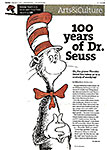
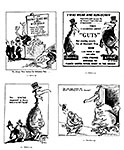
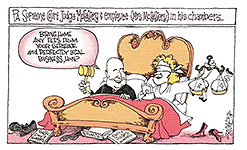

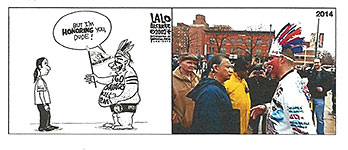
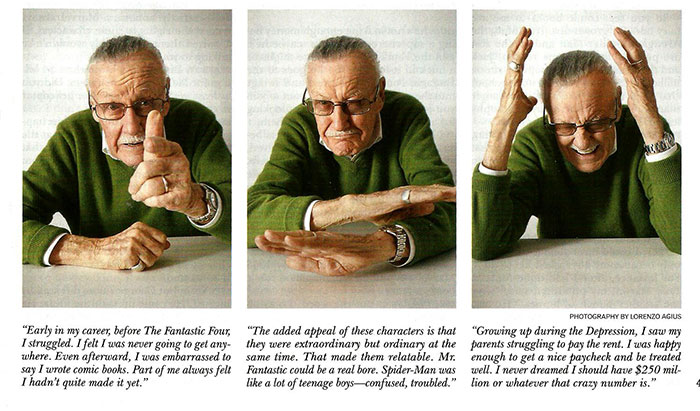
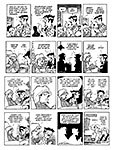
1.jpg)
2.jpg)
3.jpg)
4.jpg)
5.jpg)
6.jpg)
7.jpg)
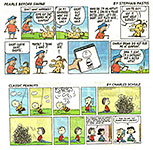
1.jpg)
2.jpg)
3.jpg)
4.jpg)
5.jpg)
